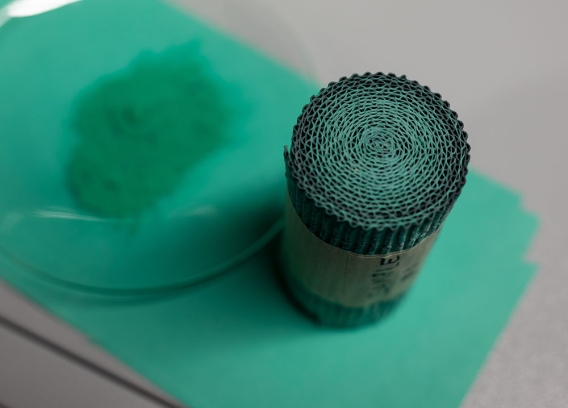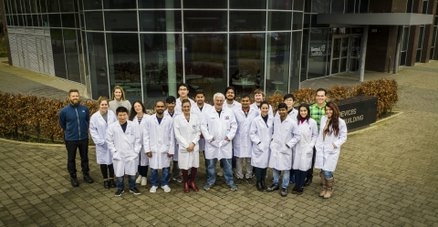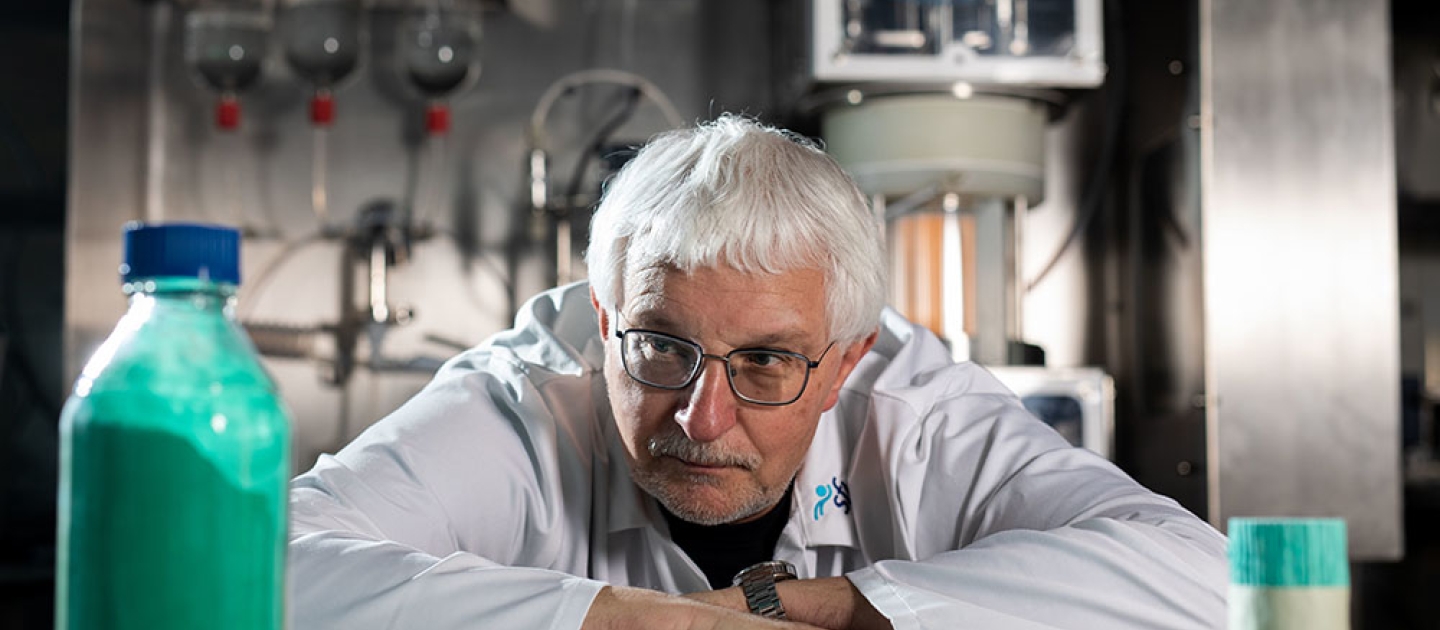It started with a dream 30 years ago. The dream was of crystal engineering, that material science would become like architecture and allow intervention in nature to design new materials.
Professor Michael Zaworotko is standing in a lab at the Bernal Institute at University of Limerick. He is holding a jar of powdered green material in one hand and a thinly rolled stack of green paper in another.
“This,” he smiles, indicating to the green powder, “is the secret sauce”.
“And this,” he nods at the wrap of paper, “is the end product”.
This unassuming scientist, ‘Mike Z’, is discussing how he and his team at the Bernal have made major discoveries to affect global energy consumption. The discovery of a revolutionary new material could help solve the global water crisis by producing water from air, even in the most remote of locations.
The dream, made reality.
Prof Zaworotko’s lab has developed a crystalline material after decades of research that has favourable properties for absorbing and releasing water from the atmosphere that could revolutionise dehumidification systems in buildings and the availability of water in regions of drought.
The green material is ROS-037 and it has been developed as a commercially viable nanomaterial by Molecule RND LTD, an international think tank, research group and incubator fund that has located in UL to work in collaboration with Prof Zaworotko and his team.

The idea is that the water capture material – a low energy desiccant – would replace the silica traditionally used in dehumidification systems in buildings.
It could also be used to “wick water from the air”, with potentially incredible ramifications for arid, water starved regions. The end product that can be installed in existing dehumidifiers is the wrap of paper Zaworotko holds in his other hand.
“The potential is that it’s one of the biggest inventions in history,” says Prof Zaworotko with the air of someone not given lightly to exaggeration.
“Clean water at will is something that is game changing. It is even more tangible to many people’s everyday lives. The beauty is there is a market, there is an urgent need here that is not being filled by the current technologies.
“But it goes further than this, it goes to cleaning up agriculture, producing medical grade water in hospitals – it has a huge variety of potential applications,” he adds.
The application of this new material is not limited to water. Prof Zaworotko, along with Kai-Jie Chen, Amrit Kumar, David G. Madden and Soumya Mukherjee, recently wrote a paper for the highly prestigious journal Science about the energy efficient purification of ethylene. Another dream on its way to becoming reality.
Mike Zaworotko is the Bernal Chair of Crystal Engineering and Science Foundation of Ireland Research Professor and co-director of the Synthesis and Solid-State Pharmaceutical Centre, to give him his full title, and a rock star of the research world.
He was recently named among the world’s most influential researchers by the Web of Science group and in April of last year was awarded almost €1m in ground-breaking research funding to study a new class of materials aimed at solving global challenges related to commodity purification.
In October, he was admitted to the Royal Irish Academy, considered the highest academic honour in Ireland.
Today, he is keen to tell the “story of the long journey of how we started with a dream 30 years ago and ended up today with something much more than pretty structures and papers – which is properties that are relevant to real world applications.

“The dream was that material science would become like architecture. That we could be like architects and make materials by design, that a chemist could create a material with the right structure and the right properties – as opposed to nature being what it is, that a person could intervene and design new classes of materials.
“The dream is a lot older than the early 1990s, that is just when I started my involvement in the area.
“What it boils down to – it is all about energy. How much energy does it cost – because that is the real cost of everything.
“How much energy do you have to spend to produce and purify ethylene? How much energy do you have to spend to produce water? They can all be done, but they cost a lot of energy. And so desiccants are everywhere; water capture is easy. You can dry things up, but dehumidifiers use a lot of energy.
“It is all about the recycling – it is not the capture, it is the combined capture and release cycle. If you get the right sweet spot, then you dramatically change everything. The economics, the energetics – everything just changes.”
Molecule have companies and countries queuing up to test and apply the commercialisation of the material, all of the research for which was carried out at the Bernal Institute, where Mike and his team of 20-plus researchers are based.
“Well, the easiest part of the story – in one sentence, what the application is and how it will affect the world: We will make clean water available to anybody in the world, by pressing a button, with very low energy footprint. That is only one application – that is the most exciting, valuable thing you could do, I think, right now, the lowest lying fruit,” explains Prof Zaworotko.
“Being without water is something that is affecting billions of people already. There is no Plan B for water,” he adds.
The next step, the Bernal researcher says, has massive potential implications for climate change.
“CO2 is another goal, but it is not so tangible. Things are getting worse in terms of CO2 levels, but it doesn’t have an immediate effect – it might be 50 years before the tip over point happens, which people are talking about, when it will be almost irreversible,” Mike explains.
“CO2 is, I would say, the second lowest lying fruit. And it is a very juicy one too, because there are immediate industrial applications – but there is also competing technology. So it can be done. You can’t make pure water in the desert at the moment, but you can capture CO2 in industrial processes – but it is energy intensive.
“If we can cut that cost, and we are not talking one or two percent, we are talking 50-90% reduction in the energy footprint – that will then have an effect on CO2 emissions and the global CO2 level.
“We are going after CO2,” he adds, smiling at the prospect of another dream that is about to be realised.
- Alan Owens
